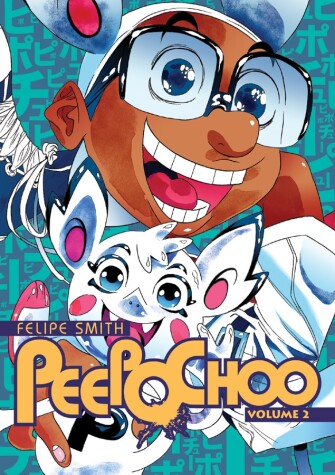Peepo Choo
3 primary works
Book 1
They say you cannot choose where and when are born; we are gifted into the worlds are parents are living at the time. Whether a blessing or a curse, as individuals we must make the most of our environments to advance as best possible given the circumstances present. For the cast of Peepo Choo, their places of birth, whether they be the suburbs of Tokyo or the South Side of Chicago, appear to be a curse they cannot escape...until they realize the world is a much smaller place than they thought.
On the surface Milton appears to be your average a high school student living in the thugged out streets of Chicago's South Side. As is the case with many teens looks can be deceiving. When he's not at school or riding the metro, he is at the local comic shop cosplaying as his favorite Japanese animation character Peepo Choo! A hardcore fan, Milton knows every line from the Peepo Choo animation by heart. He can happily replicate the Peepo Dance with ease, and genuinely believes the world depicted in this cartoon is "the real" Japan.
On the other side of the Pacific lives Reiko. A teenage model on the rise, she also has another side of her. Reiko is a feminist working hard to someday move overseas to a place where she could be treated equally and fairly by men and women. In Japan, Reiko feels she is a teenage sex object, and after a number of interactions with young Americans in Tokyo she begins to believe that her American dream is going to be painfully similar to her worst Japanese nightmares.
Chance would bring the two teens together. But in this case fate comes in the form of the underworld!
"Now that Smith is producing works for a Japanese audience under the editorial guidelines of Kodansha--doing what Paul Pope in the 1990s ultimately could not do--it's going to be fascinating to see how his already amazing talents change and grow."--Jason Thompson, ComiXology
On the surface Milton appears to be your average a high school student living in the thugged out streets of Chicago's South Side. As is the case with many teens looks can be deceiving. When he's not at school or riding the metro, he is at the local comic shop cosplaying as his favorite Japanese animation character Peepo Choo! A hardcore fan, Milton knows every line from the Peepo Choo animation by heart. He can happily replicate the Peepo Dance with ease, and genuinely believes the world depicted in this cartoon is "the real" Japan.
On the other side of the Pacific lives Reiko. A teenage model on the rise, she also has another side of her. Reiko is a feminist working hard to someday move overseas to a place where she could be treated equally and fairly by men and women. In Japan, Reiko feels she is a teenage sex object, and after a number of interactions with young Americans in Tokyo she begins to believe that her American dream is going to be painfully similar to her worst Japanese nightmares.
Chance would bring the two teens together. But in this case fate comes in the form of the underworld!
"Now that Smith is producing works for a Japanese audience under the editorial guidelines of Kodansha--doing what Paul Pope in the 1990s ultimately could not do--it's going to be fascinating to see how his already amazing talents change and grow."--Jason Thompson, ComiXology
Book 2
The version of Tokyo Milton is now witness to is nothing like what he saw in his favorite cartoons and comics. While he has seen brief flashes of the futuristic and techonogically advanced Japan seen in the media, he has not experienced the side of Japan COOL that pop culture circuits have been promoting back in home. Instead Tokyo is a bustling and surprisingly quiet megaopolis where salarymen are seen more often than cosplayers, and no one seems to have read the Peepo Choo manga. What's more, those who do read comics, and they come from every age group and demographic there, are reading comics about sports heroes, office employess, wine tasters and politicians instead of ninjas and giant robots.
How could this Japan also be the same Japan that has talking toilets? "And how can a country of freedom and independence built by immigrants be so racist and sexist," says Milton's new Japanese acquaintence Reiko. She grew up loving the concept of America. In her mind it was nothing like the patronist society that is modern day Japan. However, whenever she would meet Americans in Tokyo or chat with them online, all she got was abuse. Women would treat her coldly; men would immediately hit on her. In a way the people of America are worse than the Japanese, as they are more open with their rude behavior.
Somewhere between these two young people there is a commonanlity of culture clash. And it is that which will bring the two together in a mutual understanding of each other's culture and one another.
How could this Japan also be the same Japan that has talking toilets? "And how can a country of freedom and independence built by immigrants be so racist and sexist," says Milton's new Japanese acquaintence Reiko. She grew up loving the concept of America. In her mind it was nothing like the patronist society that is modern day Japan. However, whenever she would meet Americans in Tokyo or chat with them online, all she got was abuse. Women would treat her coldly; men would immediately hit on her. In a way the people of America are worse than the Japanese, as they are more open with their rude behavior.
Somewhere between these two young people there is a commonanlity of culture clash. And it is that which will bring the two together in a mutual understanding of each other's culture and one another.
Book 3
In this final volume of Peepo Choo, Milton and Reiko begin to develop their own dialog. Milton has begun to understand that there is much more to appreciate about this culture than he imagined. He also realizes that there was nothing wrong with being who he is as long as he is being earnest. Sure that might isolate him in certain conditions, but it may also prove to be charming; as in the case with his new friend Reiko.
Reiko's views on American people also begin to change. People are who they are no matter where they hail from, and while the media and geo-political issues may influence subcontext it does not change individual personalities. She knows what she wants and she is willing to do whatever possible to achieve her goals in life. Her future might not be in Japan. They might not be in the US. But she will clearly be looking forward to a future where she is judged on her merits and talents with equity and honesty.
Together they have much of that, but they are also very young. The future has many options for these two. So when they part ways at the end of this trip, one has to wonder...Will they ever see each other's home the same way again?
Reiko's views on American people also begin to change. People are who they are no matter where they hail from, and while the media and geo-political issues may influence subcontext it does not change individual personalities. She knows what she wants and she is willing to do whatever possible to achieve her goals in life. Her future might not be in Japan. They might not be in the US. But she will clearly be looking forward to a future where she is judged on her merits and talents with equity and honesty.
Together they have much of that, but they are also very young. The future has many options for these two. So when they part ways at the end of this trip, one has to wonder...Will they ever see each other's home the same way again?


